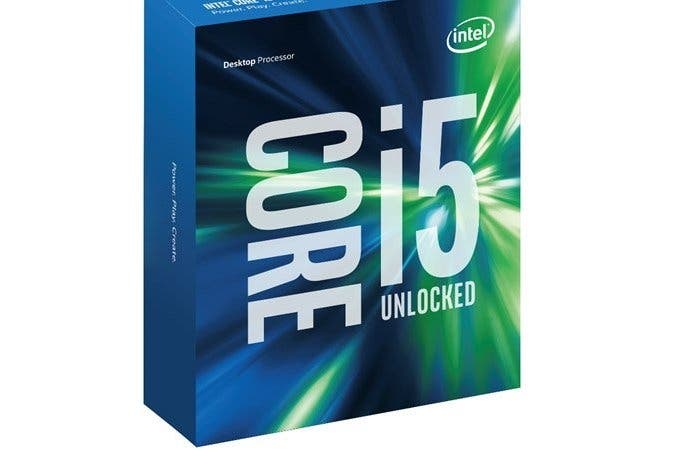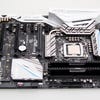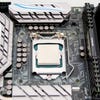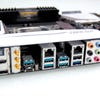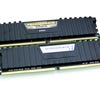Intel Skylake: Core i5 6600K review
The CPU upgrade you've been waiting for?
In the last few years, reviewing an Intel CPU from a gaming perspective has always been something of a challenge. Typically, the conclusion is this - if you already own a modern Intel chip, there's little reason to upgrade; but if you're buying or constructing a new PC, there's nothing better on the market. Gone are the days of the first and second-gen Core (codenamed Nehalem and Sandy Bridge), which offered substantial generational improvements. Intel's focus is now firmly on mobile, where efficiency takes point over raw performance, which serves to diminish the excitement over a new desktop release.
There's a strong argument that Intel's latest processing architecture - Skylake - follows the same strategy. Break out your synthetic benchmarks and your video encoders and performance increases over the outgoing Haswell once again only show an iterative uplift. However, based on our testing, Skylake is more interesting than the benchmarks would have you believe.
Part of its fascination is based on the fact that the new processor actually carries two generations worth of optimisations - Intel's recent Broadwell architecture rolled out fully on mobile, but only had a very limited release on desktop. Owing to delays with its cutting-edge 14nm production technology, Intel only released two niche Broadwell processors with most of the desktop line skipping straight ahead to Skylake. On top of that, the latest Intel architecture is surrounded by an entirely new platform - which has the possibility of bringing its own performance improvements into the mix.
That does mean that owners of existing socket 1150 motherboards supporting Haswell and Broadwell chips will need to upgrade: the new Z170 chipset uses a new socket 1151 connection for the CPU that's incompatible with older hardware, but on the plus side, you do get a bunch of new features - Skylake feature a 40 per cent increase in PCI Express I/O lanes, meaning that there's more bandwidth available for high-speed storage and the new USB 3.1 standard. Next-gen M.2/NVMe PCI Express support in some boards also allows for cutting-edge storage to be used natively in RAID. However, despite the increase in PCI Express bandwidth, multi-GPU options are unchanged from last-gen: you can have one card with PCI Express x16 bandwidth, or two with x8. However, perhaps the biggest change is the move to the new DDR4 memory standard, taking system RAM bandwidth to the next level.
- Buy the Intel Core i5 6600K from Amazon with free shipping.
Skylake also has improved overclocking capabilities too. Processor speed is defined by the base-clock - typically 100MHz on recent Intel processors - and the multiplier. The i5 6600K has a base clock of 3.5GHz, meaning 'BCLK' of 100MHz combined with a 35 multiplier. There's only limited BCLK tweakery available on most recent Intel CPUs, and the overclock is defined almost entirely by the multiplier. Skylake changes things here - both can be tweaked at will, allowing for finer grain overclocking. As it is, our CPU sample topped out at 4.5GHz - anything higher and one of the cores wouldn't operate correctly, even when we moved voltage into the 1.4v territory (not something we'd recommend generally - our Skylake sample got very hot at this level). Sticking to 4.5GHz and 1.375v, thermals under load via air cooling stabilised in the early 70s. Not bad, but a higher-end cooler would most likely improve matters still further. For our upcoming i7 6700K review, we'll be pushing the boat out a little with a Corsair 100i GTX closed loop cooler.
But let's get cracking with some standard benchmarks on the i5 - mostly synthetics that give some kind of outlook on single-core and multi-core performance. We have two generations of CineBench results, combined with x264 video encoding and Futuremark's 3DMark physics test - designed to accurately model a particular kind of game engine load. We sourced results from a range of CPUs - two generations of i7, three generations of i5 and an AMD FX-8350.
Results show anything from a five to 15 per cent increase in performance compared to the Devil's Canyon i5 4690K, with the new i5 drawing close to the Ivy Bridge Core i7 3770K, but falling short of the last-gen i7 4790K in multi-threaded scenarios. Remember the key difference between the desktop i5 and its i7 counterparts - no hyper-threading. In synthetics and video encoding at least, clearly this makes a substantial difference, but the improvements to per-clock performance are far more important for gaming, as we'll see.
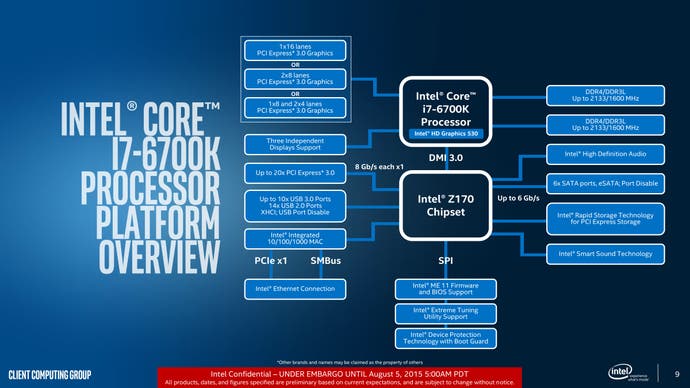
| i5 6600K | i5 6600K/ 4.5GHz | i7 4790K | i7 3770K | i5 4690K | i5 3570K | i5 2500K | FX-8350 | |
|---|---|---|---|---|---|---|---|---|
| CineBench 15 Single Thread | 158 | 184 | 172 | 134 | 145 | 131 | 129 | 98 |
| CineBench 15 Multi Thread | 618 | 702 | 840 | 657 | 537 | 505 | 492 | 640 |
| CineBench 11.5 Single Thread | 1.81 | 2.08 | 1.97 | 1.65 | 1.71 | 1.56 | 1.48 | 1.11 |
| CineBench 11.5 Multi Thread | 6.96 | 7.94 | 9.62 | 7.83 | 6.57 | 5.97 | 5.78 | 6.74 |
| x264 Video Encoding | 15.03 | 17.18 | 19.07 | 15.02 | 14.22 | 11.98 | 10.98 | 14.97 |
| 3DMark Physics | 8718 | 9913 | 12180 | 10105 | 7787 | 6901 | 6712 | 7520 |
It's not easy to accurately represent the raw capabilities of a CPU during gaming. Consider the role of the processor - it simulates the scene, and it prepares instructions for rendering it for the graphics card. In the vast majority of gaming PCs, frame-rate is more usually limited by the graphics hardware, meaning that most benchmarks aren't exactly indicative of how well the CPU is doing its job, or its characteristics under maximum load. Previous methodology we've seen has either ignored this - leading to results that show the majority of CPUs handing in identical performance, or else resolution is lowered and settings dropped to take the GPU out of the equation. This might sound better, but it also lowers the CPU load when it comes to preparing the command list for the graphics hardware - so it's not ideal.
Previously, we've tackled this by remaining at ultra settings, but knocking down resolution to 720p in order to do our best to remove graphics as the bottleneck without compromising CPU workload. However, with the arrival of Nvidia's borderline insane Titan X and its overclocking prowess, we now feel confident about repeating this process at 1080p - by far the most popular gaming resolution according to the Steam hardware survey. To put the new i5 into context, we've repeated the same tests on the three prior generations, and included the AMD FX-8350 too in order to give some idea of how Intel's rival stands.
There is a standout result here. The Witcher 3 is 17 per cent faster on the new 6600K, compared directly to the old 4690K - a result that is repeatable (and our initial tests on the new i7-6700K show that it is even faster) and obviously significantly beyond the vast majority of the synthetic results. We've chosen this particular scene because we know that it easily overpowers the 4690K, and even the 6600K at stock speeds maxes out on all four cores. It's the most strenuous test in our line-up, but there are other noteworthy results: GTA 5 is 11 per cent faster and Battlefield 4 sees a 10 per cent uplift. Other titles are less impressive - five per cent or lower. Based on the relatively level frame-time graphs, we believe that we may still be GPU limited.
| 1920x1080/Titan X OC (Avg FPS) | Core i5 6600K | Core i5 4690K | Core i5 3570K | Core i5 2500K | FX-8350 |
|---|---|---|---|---|---|
| The Witcher 3, Ultra, HairWorks Off, Custom AA | 89.5 | 76.3 | 73.1 | 71.1 | 75.1 |
| Assassin's Creed Unity, Ultra High, FXAA | 86.8 | 84.8 | 80.8 | 77.9 | 75.1 |
| Battlefield 4, Ultra, 4x MSAA | 127.8 | 116.5 | 108.2 | 102.1 | 103.0 |
| Crysis 3, Very High, SMAA | 109.4 | 108.1 | 104.8 | 102.3 | 99.2 |
| COD Advanced Warfare, Extra, FSMAA | 192.0 | 183.0 | 172.8 | 168.5 | 138.3 |
| Grand Theft Auto 5, Ultra, no MSAA | 70.2 | 63.0 | 58.2 | 56.3 | 47.5 |
| Far Cry 4, Ultra, SMAA | 89.9 | 87.6 | 81.7 | 79.7 | 63.7 |
| Shadow of Mordor, Ultra, High Textures, FXAA | 132.7 | 132.7 | 131.0 | 126.6 | 100.9 |
| Ryse: Son of Rome, High, SMAA | 112.9 | 110.6 | 104.0 | 102.7 | 92.8 |
With the new i5 comparing favourably to its predecessors, we thought we'd go one step further, pitting the new chip against the last two generations of mainstream i7s - the epic Devil's Canyon Core i7 4790K and the still-worthy Core i7 3770K, hailing from the Ivy Bridge generation. We've also factored in the new chip running with the 4.5GHz overclock in place. The end results are impressive: average frame-rates at stock speeds beat the 3770K on all but two titles - Crysis 3 and The Witcher 3. The 6600K is also faster than the 4790K in Call of Duty and GTA 5, though its wins in Battlefield 4 and Ryse are margin of error stuff. The i5's performance increases still further with the 4.5GHz overclock in place, beating the stock i7s on all titles. However, on some games that utilise more than four threads, there is the suggestion that the i7s stutter less.
We would have loved to have seen the new i5 knockout the last-gen i7 but regardless, these results are impressive overall. There's an argument that could suggest that the test scores are levelled off since we're GPU-limited - and we strongly suspect that in the case of Assassin's Creed Unity and Shadow of Mordor at least, that is more than likely the case. But on the flipside, The Witcher 3 and Grand Theft Auto 5 are clearly CPU-bound - and the i5 hands in some excellent results there.
And just one more point: consider the way that games are made these days. Not every title spreads its computational load equally across four or eight threads. Take Far Cry 4, for example. It's a multi-core game, but it relies to a disproportionate level on one thread to power the others. Take a look at what happens there when we overclock: there's an enormous improvement to overall performance - the boost actually looks unfeasibly high. The i5 propels itself from behind the Devil's Canyon i7 and pulls ahead. Far Cry 4 is a bit of a difficult game to consistently benchmark, but the results here both at stock and overclock were repeatable in our tests and demonstrates that even in the multi-core era, Intel's pursuit of ever high per-clock efficiency can pay dividends in the gaming arena.
| 1920x1080/Titan X OC (Avg FPS) | Core i5 6600K | Core i5 6600K/4.5GHz | Core i7 4790K | Core i7 3770K |
|---|---|---|---|---|
| The Witcher 3, Ultra, HairWorks Off, Custom AA | 89.5 | 98.2 | 92.4 | 91.9 |
| Assassin's Creed Unity, Ultra High, FXAA | 86.8 | 87.2 | 86.9 | 85.0 |
| Battlefield 4, Ultra, 4x MSAA | 127.8 | 130.6 | 126.1 | 124.5 |
| Crysis 3, Very High, SMAA | 109.4 | 117.0 | 116.4 | 112.0 |
| COD Advanced Warfare, Extra, FSMAA | 192.0 | 203.7 | 187.5 | 178.4 |
| Grand Theft Auto 5, Ultra, no MSAA | 70.2 | 80.6 | 67.9 | 60.9 |
| Far Cry 4, Ultra, SMAA | 89.9 | 115.4 | 98.6 | 82.6 |
| Shadow of Mordor, Ultra, High Textures, FXAA | 132.7 | 138.7 | 133.7 | 130.0 |
| Ryse: Son of Rome, High, SMAA | 112.9 | 116.1 | 111.3 | 108.9 |
Intel Skylake: Core i5 6600K - the Digital Foundry verdict
Intel's Core i5 2500K came out over four years ago, and redefined expectations from our gaming CPUs thanks to its strong out-of-the-box performance and superb overclocking. It was a product ahead of its time, and many gamers haven't felt the need to upgrade since then. Even now, we'd still say it's a superb product. In putting together this article, we wanted to chart the rise of the i5 and put the new Skylake product into context. The results seem pretty clear-cut - despite its age, the old i5 is still a great workhorse, but the combination of generation upon generation of per-clock improvements, combined with the new platform make the Core i5 6600K significantly more powerful.
Our benchmarks above don't fully replicate the gameplay experience - they are designed to compare CPU architectures with graphics reduced as a limiting factor, but the bottom line is that a growing number of titles are seeing the CPU act as the bottleneck - a fully maxed GTA 5 is CPU-limited even on an overclocked Core i7 4790K, while certain scenes in the Witcher 3 on ultra settings can also cause difficulties for even the most powerful processor. Our contention is that more games like this will come along, and in demanding CPU titles, the Core i5 6600K will make a noticeable difference.
It's good to know that the Core processors continue to evolve and improve and Skylake is definitely a worthy upgrade, but for those considering a leap to the new architecture and chipset, the purchasing decision isn't 100 per cent clear-cut: in combination with a new motherboard, you'll also need new DDR4 RAM, which won't be cheap for some time yet. On the flipside, in the here and now, the new Z170 platform clearly has much to offer for those who use their PC for more than gaming. We're swiftly moving into an era where solid-state storage will take over, and the functionality found in the Z170 chipset could prove invaluable.
It's also good to know that the K chips continue to provide a decent amount of overclocking headroom - at least, based on the results gleaned from our review hardware. Now, we need to be a little cautious here. We achieved a solid 4.5GHz overclock, but our chip is an engineering sample, and retail processors can be quite different in terms of their overclocking characteristics. Skylake is based on Intel's new 14nm fabrication technology - and desktop 14nm chips based on the older Broadwell architecture have been seen to top out at 4.2-4.3GHz. It may well be the same for Skylake - we simply won't know until much more data has been crowd-sourced from retail chips.
But in the here and now, the Core i5 6600K is a strong product - at worst it provides mildly enhanced performance over its predecessors, at best it's noticeably faster and should help to reduce CPU bottlenecking during gameplay. For those looking to buy or construct a new, capable gaming PC, the i5 remains the default choice and the 6600K is the best iteration yet - AMD's older eight-core FX chips are cheaper, but our tests clearly demonstrate that despite the low-power many-core set-up of the new console CPUs, modern games generally prefer the high per-core performance that Intel provides. Impressive stuff overall then, which begs the question, just how good is the Skylake 6700K? Let's just say that the initial data already looks very impressive.
